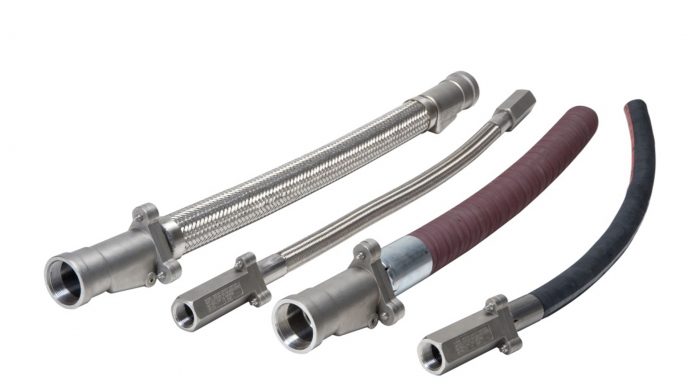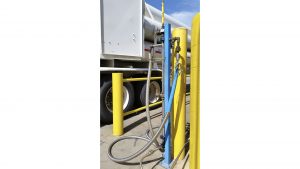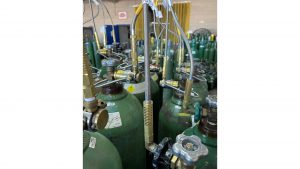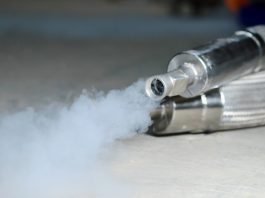LifeGuard Technologies are committed to ensuring the safety of hoses as their importance continues to grow across industries and in the green revolution.
The safety of hoses is crucial. Gary Howes, Product Manager of hydraulic hose and fittings at Parker Hannifin, said: “The end of a high pressure of petrochemical hose blowing off is the greatest risk we face. This causes the remaining portion of the hose to ‘whip’ about until flow stops and allows the medium being conveyed through the hose to escape.”
“If the medium is a gas its expansion can cause this to be extreme. Failures can result in injuries such as oil injection, burning, fire. There’s also the environmental damage from the escaping medium. Whipping hoses can cause serious injury or death.”
Government mandate for LifeGuard Safety Hose Technology
For many years, excess flow valves were identified as the solution for hose failure incidents. In the high-pressure arena, external cable ship-guards were identified as a solution to constrain the dangerous effects of a high pressure hose failure.
On 8 September, 1996, in Sanford, North Carolina, during delivery of propane to a bulk storage facility by an MC 331 bulk transport, more than 35,000 gallons of propane were released. The discharge hose separated from its hose coupling at the delivery end of the hose. Most of the transport’s 9,800 gallons of propane and more than 30,000 gallons from the storage tanks were released. If this quantity of released propane ignited, local authorities estimated that about 125 emergency response personnel could have been injured or killed.
This incident as well as many more in other petrochemical industries all pointed to a fundamental flaw in the fluid transfer system – over reliance on the excess flow valve. This recognition spawned a landmark Rulemaking issued by the United States DOT-RSPA in which they declared formally that excess flow valves are not reliable to address hose failures and new technology – the Passive Safety Hose technology was identified to provide a greater degree of safety and reliability.
Thus the term, passive safety technology was created and codified by the governments of the United States, Canada, Mexico and India around the LifeGuard Safety Hose technology as shutdown equipment that has the capability to shut off the flow of product without human intervention within 20 seconds of an unintentional release caused by complete separation of a delivery hose. This rulemaking marked the first of several important, steps that have since been taken to require LifeGuard Safety Hose technology to address the consequences of transfer line failure by relying upon systems other than excess flow valves in the United States, Canada, Mexico and India.
Who is LifeGuard Technologies?
LifeGuard Technologies is based in Philadelphia, Pennsylvania. It began with Joe Abrams’ work in cryogenics in 1958, and today the company has hoses worldwide in all industries and applications. More than 500,000 hoses with this technology have been sold since its invention including all Tier One and Tier Two gas companies making it the ‘Hose of Choice’ for the industrial and compressed
gas industry.
Joseph Abrams, the late Chairman and Director of Engineering once said: “Most inventions are doomed to rapid extinction, but a few may make evolutionary inventions, and I hope that my technology will save lives for many years to come.”
LifeGuard Technologies is a primarily technology-based company developing hose-based safety systems and promoting applications based upon the experience of its principals in the compressed gas and petrochemical industry. Once called ‘The Uber’ of the hose industry by Vittorio Zurletti, formerly Senior Manager Air Liquide, because of its unique approach to global manufacturing, LifeGuard Technologies recognised the critical need to deliver a consistent product upon a global delivery platform. Following the aggregator model, LifeGuard Technologies has established joint ventures with highly qualified factories and maintains an ownership position in them, utilising their existing infrastructure to manufacture its patented and patent pending design in a logistically advantageous but cost-effective manner.
The history of hose safety
In 1986, Joseph Abrams divested Woodland Cryogenics Inc., from his former company
Woodland Oxygen Supply Company. Woodland Cryogenics was an equipment supplier for the cryogenic and cylinder processing segments and a recognised industry leader in cylinder fill plant equipment design and manufacturing, with field cryogenic services and repair.
The company was also a major equipment supplier to independent welding distributors, Praxair, Linde Gas and Air Liquide in the US and Canada. Working in tandem with the Air Liquide Canada engineering team, including Mohand Abdelli, Joseph Abrams sought to eliminate the use of the external ‘Whip Guard’ cable due to its cumbersome nature and frequent nonuse by cylinder filling personnel to develop the ‘LifeGuard Safety System.’
Since the sale of Woodland, the essence of LifeGuard Technologies mission is, on a global geographical basis, is to provide reliable, readily deployable, and cost-effective hose safety improvements to increase the safety of all operations and facilities for which our hoses are deployed.
With global headquarters and manufacturing sites in the United States, Sweden, Canada, India, Australia and sales office in the United Arab Emirates, LifeGuard Technologies serves customers in more than 78 countries around the world. Since the technology’s inception, LifeGuard Technologies has filed more than seven patents and improved the initial technology to modify its original design, by addressing the possible consequences of heat build-up. This has been done by relocating the internal plunger away from the seat and increasing the internal surface area, thereby eliminating the risk zone of adiabatic compression.
Andy Abrams, Executive Vice President, said: “Accelerating adoption of our patented safety hose system globally and across the compressed gas and petrochemical industry,” is one of the priorities for the company within the next five years. According to Abrams, they have created an international standard for LifeGuard Technologies products by working closely with Linde and Air Liquide in the compressed gas industry and AmeriGas, Indian Oil and others in the LPG industry.
How does the LifeGuard Safety Hose work?
The LifeGuard Safety Hose and LifeGuard Tri-Bolt Breakaway Hose® technology is designed to eliminate the consequences of the hazardous effect of a drive away, coupling separation, hose rupture or failure during fluid or gaseous transfer operations.
All LifeGuard Safety Hose designs, utilise the unique, patented and patent pending design eliminating the potential for disaster through the use of an internal compression spring or monel cable connected to specially designed, normally unseated valve ‘flappers or plungers’ located on each end of the cable. This cables spring-like effect provides thrust in the direction of both ends of the hose, holding the valves open. Should this thrust be eliminated due to coupling ejection, hose stretching or hose separation, the valves release and instantly seat, stopping flow in both directions.
For larger diameter hose requirements (1 ½- 8”) the LifeGuard Tri-Bolt Breakaway Hoses® incorporate a coated Engineered Compression Spring specifically designed for each applications unique flow and pressure. In the case of a Drive-Away, the specifically designed Tri-Bolts will break causing the system to immediately engage and instantly seat stopping the flow in both directions.
Markets and product range
LifeGuard Technologies core business is safety technology. While we have become very well known for our LifeGuard Hydrogen Safety hoses, we serve all industries, applications, and pressures globally. The company has one goal and that is safety. The company’s patented and pending technology is cost-effective and easy to deploy is used on every continent.
The product line encompasses hoses and safety systems from ¼- 8”and can be deployed in any application and pressure.
Jack Fedena, Senior Technical Sales Manager said: “We do not make hoses; we make your hoses safer. We can put our technology on the hoses that you currently use and are comfortable with making the hose in the transfer process, long a cause for concern for safety officers and plant managers an element in a facilities line of defence.”
Existing industry acceptance
The company is in a unique and enviable position; it is positioned to take advantage of the increasing demand for safety by industry and community as well as imminent new safety regulations. In a world increasingly sensitive to safety and facing not only the dangers inherent in product handling, government and industry must also prepare for intentional damage to facilities.
Tier One and Tier Two Gas companies have been adopting the LifeGuard Safety Hose technology for many gaseous applications in cylinder filling and tube trailer offloading including hydrogen.
Dating back to the mid-nineties, several Tier One Gas Companies began adopting passive hose safety in their fill plant hoses. After several validation tests including cycle tests, and many years of experience with LifeGuard Safety Hoses, one has changed their hose cycle life standards. Specifically, all conventional hoses replacement specifications remain similar to other Tier one gas company standards except now LifeGuard Safety Hoses are exempt from cycle life replacement.
This new standard recognises the inherent safety features of LifeGuard Safety Hose passive safety technology when combined with our hose supplier’s hose components and assembly procedures to create a design that can safely remain in service until regular inspection processes identify wear and tear issues requiring removal from service.
A long-standing global supplier of hoses to Air Liquide since 1992, LifeGuard provided and continues to provide nearly a thousand, 1 ½ inch by 14 feet convoluted metallic hoses.
Chad Laflin, Manager of Engineering Technologies at Air Liquide Industrial U.S., who was directly involved in the design and implementation of this project, said: “Not only does this project display Air Liquide’s commitment to safety, it also shows competitors and customers our standard for this application and may entice some movement to adopt a similar standard improving safety across the industry.”
Growth and competition
Since its founding LifeGuard Technologies has consistently refined its product and developed new products for client specific applications. Year on year growth has exceeded 15% for from 2017 through 2023.
Andy Abrams, Executive Vice President, said: “While there is competition, we are the only device that seals itself at both ends but with a controlled breakaway separation to avoid ripping the piping out of the truck or facility. Our compression spring enables us to handle very high flow due to its adjustability. There is no training required you simply replace your existing hoses. There is minimal price difference in most instances with the cost virtually the same as the hose as you are using. When the additional safety and regulatory relief that is unique to us are considered, our technology simply becomes a must have.”
Future expectations
LifeGuard Technologies mission is focused and simple to make the world’s safest hoses. The company expects that the current global environment of safety concerns and environmental awareness will continue to expand.
LifeGuard believes that its core capability resides with our technology, patented and pending, as well as our more than 120 years of experience in the industrial gas and petrochemical industries. To that end, we have focused on the technical development of our products and the establishment of world class assembly facilities. The necessity of geographical accessibility between service provider and the customer has been essential for face-to-face contact in our industries.
LifeGuard Technologies has restricted the production/assembly of its products to facilities that are ‘centers of excellence’, in which specialised production capacity is available for the manufacture of unique quality products. Moreover, LifeGuard Technologies expects to be investing in the development of new, original safety products by means of internal and external forms of cooperation in order to preserve our innovative clout and flexibility.
New applications
Hazards associated with handling gaseous or liquid hydrogen are fire, explosion, and pressure. Hydrogen is easily ignited by open flames, electrical sparks and static electricity. A hose failure can literally be catastrophic. Safety for our workers and our community is our top priority.
Newest products
On 29 September, 2023, LifeGuard Technologies expanded its Hydrogen Safety Hose Product Line with the launch of LifeGuard Vacuum Jacketed Hydrogen/Helium Safety Hose, the cryogenic industry’s first patent pending LifeGuard Vacuum Jacketed Safety Hose specifically designed for liquid hydrogen and helium transfer. The vacuum technology with super insulation and the patented and patent pending LifeGuard Safety Internal Shutoff System precisely provides the insulation, value, quality, and safety required to transport liquid hydrogen.
Andy Abrams, Executive Vice President of LifeGuard Technologies, said: “At a time when the hydrogen industry is on the cusp of massive expansion, it is critical that safety lead the way. Now, liquid hydrogen transfer can have the same technological safety features that our LPG, NH3 and high-pressure hydrogen and atmospheric gases hoses have enjoyed for more than 20 years.”
“We look forward to offering this new hose design to our Compressed Gas and petrochemical customers through our global network of locations helping to drive LifeGuard Safety Hose adoption even further into the hydrogen industry.”
Safety is a key priority for the hydrogen industry, as it is essential for its growth and acceptance as a sustainable energy solution. By understanding and managing the safety hazards associated with hydrogen including the ‘weakest link’ – the transfer hose – the industry can ensure its safe production, storage, transportation, and use in various sectors.
The future of LifeGuard Safety Hose technology
The LifeGuard Safety Hose technology is perfectly positioned with more than 30 years of successful performance in the compressed gas, petrochemical and hydrogen industry, with global delivery platforms in five continents, to see its vision of all hoses used in hazardous gas and liquid transfer to include the LifeGuard Safety Hose technology.
We have always believed that excellence is the gradual result of always striving to do better. LifeGuard hose technology offers gas industry professionals an opportunity to improve process safety in the filling, transportation and customer use of petrochemicals and compressed gas. Being a self-deploying device, single incidents can be snuffed out at the earliest opportunity, without the need for human intervention. This is the optimal additional layer of safety.
Please note, this article will also appear in the sixteenth edition of our quarterly publication.












